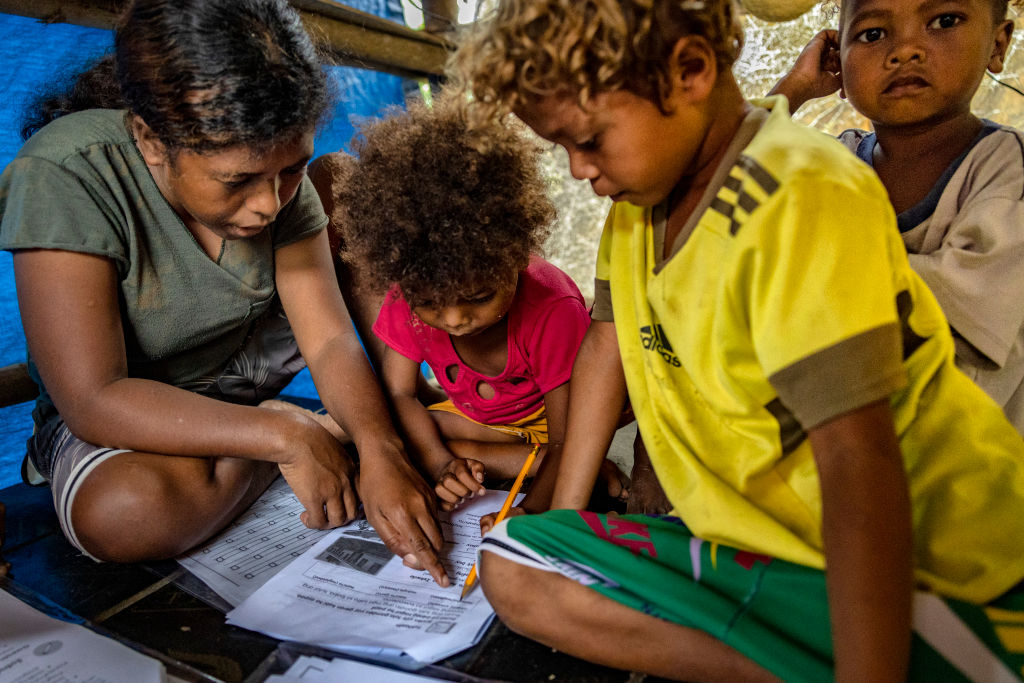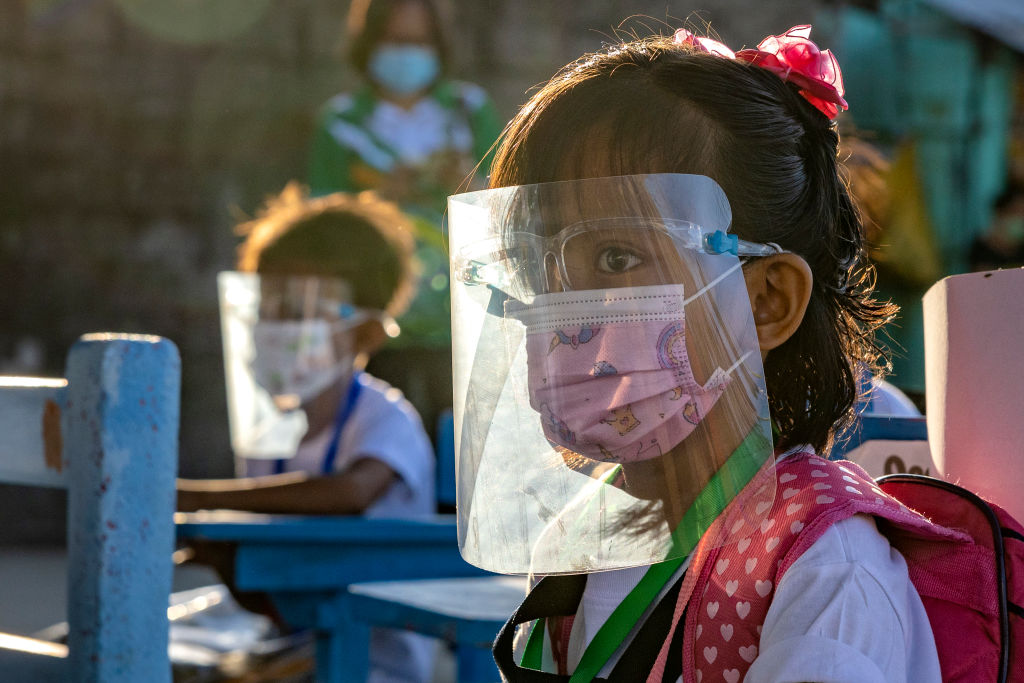
If 17-year-old Ruzel Delaroso needs to ask her teacher a question, she can’t simply raise her hand, much less fire off an email from the kitchen table. She has to leave the modest shack that her family calls home in Januiay, a farming town in the central Philippines, and head to an area of dense shrubbery, a 10-minute walk away. There, if she’s lucky, she can pick up a phone signal and finally ask about the math problem in the self-learning materials her mother picked up from school.
“We’re so used to our teachers always being around,” Delaroso tells TIME via the same temperamental phone connection. “But now it’s harder to communicate with them.”
Her school, Calmay National High School, is among the tens of thousands of Philippine public schools shuttered since March 2020 because of the COVID-19 pandemic, and Delaroso is one of 1.6 billion children affected by worldwide school closures, according to a UNESCO estimate.
But while other countries have taken the opportunity to resume in-person classes, the Philippines has lagged behind. After 20 months of pandemic prevention measures, amounting to one of the world’s longest lockdowns, only 5,000 students, in just over 100 public schools, have been allowed to go back to class in a two-month trial program—a tiny fraction of the 27 million public school students who enrolled this year. The Philippines must be one of a very few countries, if not the only country, to remain so reliant on distance learning. It has become a vast experiment in life without in-person schooling.
Read More: What It’s Like Being a Teacher During the COVID-19 Pandemic
“[Education secretary Leonor Briones] always reminds us that in the past when there were military sieges, or volcanic eruptions, earthquakes, typhoons, floods, learning continued,” says education undersecretary Diosdado San Antonio.
But has it this time? Educators fear that prolonged closure is having negative effects on students’ ability to learn, impacting their futures just a time when the country needs a young, well-educated workforce to resume the impressive economic growth it was enjoying before the pandemic hit.
Globally, COVID-19 will be impacting the mental health of children and young adolescents for years to come, UNICEF warns. School shutdowns have already been blamed for a rise in dropout rates and decreased literacy, and the World Bank estimates that the number of children aged 10 and below, from low- and middle-income countries, who cannot read simple text has risen from 53% prior to the pandemic to 70% today.
If the pilot resumption of classes passes without incident, there are hopes for a wider reopening of Philippine schools. But without it, there are fears of a lost generation.

How COVID-19 impacted Philippine education
From March 2020 to September 2021, UNICEF tallied 131 million pre-tertiary students from 11 countries who had been trying to learn at home for at least three quarters of the time that they would normally have been in school. Of that number, 66 million came from just two countries where face-to-face classes were almost completely nixed: Bangladesh and the Philippines. (Bangladesh reopened its schools in September.)
Amid the initial COVID-19 surge of March 2020—just weeks shy of the end of the academic year—the Philippines stopped in-person classes for its entire cohort of public education students, which then numbered some 24.9 million according to UNESCO. The start of the new school year in September also got pushed back, as President Rodrigo Duterte imposed a “no vaccine, no classes” policy.
When schooling finally resumed in October 2020, the education department’s solution was a blend of remote-learning options: online platforms, educational TV and radio, and printed modules. But social inequalities and the lack of resources at home to support these approaches have dealt a huge blow to many students and teachers.
A departmental report released in March 2021 found that 99% of public school students got passing marks for the first academic quarter of last year. But other surveys claim that students are being disadvantaged. Over 86% of the 1,299 students polled by the Movement for Safe, Equitable, Quality and Relevant Education said they learned less through the education department’s take-home modules—so did 66% of those using online learning and 74% using a blend of online learning and hard-copy material.
Read More:Angelina Jolie on Why We Can Let COVID-19 Derail Education
Even though she’s an academic topnotcher—getting a weighted grade average of 91 out of 100 last year—Delaroso also feels that remote learning is inferior.
At Delaroso’s high school, teacher Johnnalie Consumo, 25, has detected a lack of eagerness to study, with some parents even filling in worksheets on their child’s behalf—going by the evidence of the handwriting.
“They have a hard time forcing the kid to answer modules because the kid isn’t intimidated by their parents,” she tells TIME. “The way a teacher encourages is very different from how a parent would.”
Consumo sometimes visits the homes of under-performing students and finds that they are out doing farm work—harvesting sugar cane, say, or making charcoal—to augment a family income that has been slashed by a suffering economy and a rising unemployment rate. Exercise books have been turned in blank, she says. Or students appear to pass their modules, only for her to find that they copied the answers. The frustration is enormous.
“It’s hard on our part,” Consumo tells TIME, “because we really try our best.”

Poverty and education in the Philippines
Internet access is a huge challenge. In urban areas, instructors can give lessons over video conferencing platforms, or Facebook Live, but 52.6% of the Philippines’ 110 million people live in rural areas with unreliable connectivity. It doesn’t come cheap either: research from cybersecurity firm SurfShark found that the internet in the Philippines is among the least stable and slowest, yet the most expensive, of 79 countries surveyed.
Internet access assumes, of course, that the user has a device, but in the Philippines that’s not a given. Private polling firm Social Weather Stations found that just over 40% of students did not have any device to help them in distance learning. Of the rest, some 27% were using a device they already owned, and 10% were able to borrow one, but 12% had to buy one, with families spending an average of $172 per learner. To put it into perspective, that’s more than half the average monthly salary in the Philippines.
“Some of them don’t have cell phones,” says Marilyn Tomelden, a teacher in Quezon province, three hours away from the Philippine capital Manila, who first noticed the digital divide when many of her sixth graders were unable to comply with what she thought of as a fun homework assignment: submitting videos of themselves performing dance moves she had demonstrated in an earlier video.
“Because we’re in public school, we cannot demand that they buy phones,” Tomelden says. “They don’t have money to buy their own food, and they’re going to buy their own cell phone for learning? Which is more important to live—to eat or to study?”
Instructors need to be equipped with the right resources too. A study from the National Research Council of the Philippines found that many teachers have had to shell out their own money to support their students in remote learning.
Read More: The Long History of Vaccinating Kids in School
Government agencies do what they can to help. Earlier this year, the customs bureau donated phones and other gadgets it had confiscated to the education department for distribution to needy students. But it’s a drop in the ocean.
“It’s something that is beyond [our] capacity to address—the inequality in terms of availability of resources of learners, depending on the socioeconomic status of families,” says education undersecretary San Antonio.
Some students are so exhausted by the struggle to study remotely that they are calling for long breaks between modules. Many parents and pressure groups are going even further, demanding total academic suspension until a clearer post-pandemic education system is ironed out.
Congresswoman France Castro is a member of ACT Teachers Partylist, a political party representing the education sector. She says a complete freeze would cause more problems than it solves.
“Education is a right,” she tells TIME. “Whatever form it will be, whether blended learning or modular, it’s better to continue it than to stop.”
But in the meantime, with their workloads multiplied, it is students and teachers paying the price. Consumo, the teacher from Januiay, regularly stays up late completing the reams of new paperwork generated by the distance learning system.
“You won’t be able to sleep anymore, just thinking about the deadlines and the work that still needs to be done,” she says. “I cry over that.”
More Must-Reads from TIME
- Cybersecurity Experts Are Sounding the Alarm on DOGE
- Meet the 2025 Women of the Year
- The Harsh Truth About Disability Inclusion
- Why Do More Young Adults Have Cancer?
- Colman Domingo Leads With Radical Love
- How to Get Better at Doing Things Alone
- Michelle Zauner Stares Down the Darkness
Contact us at letters@time.com